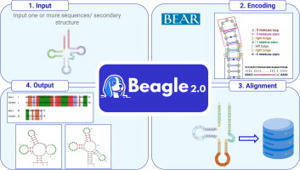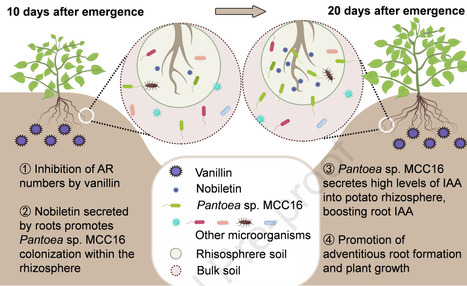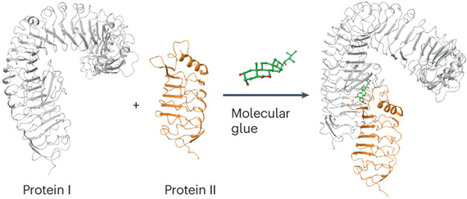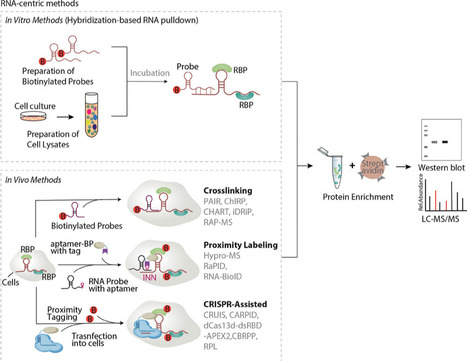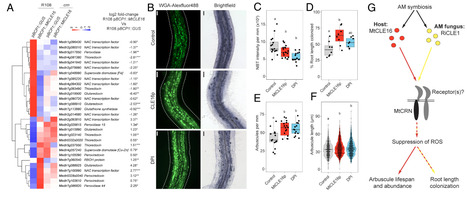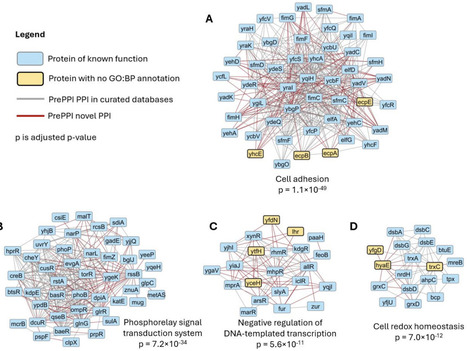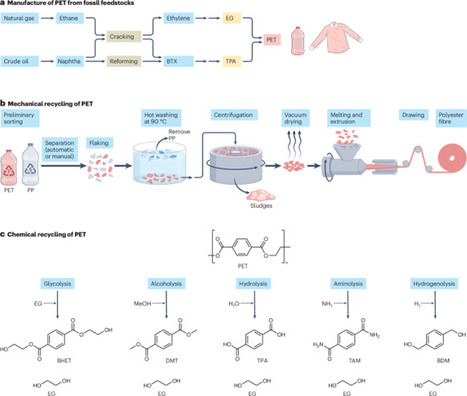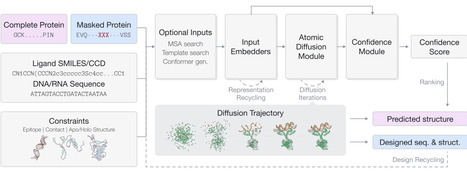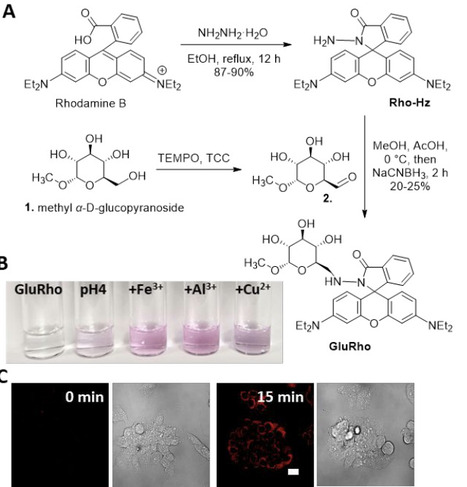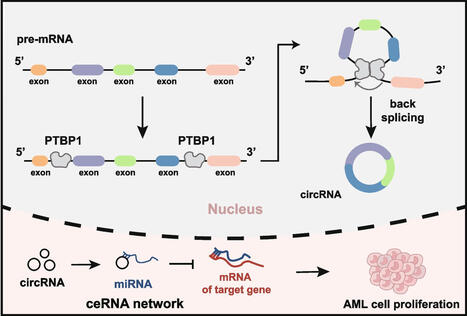 Your new post is loading...

|
Scooped by
?
Today, 4:48 PM
|
Bacterial persistence is a phenomenon in which a small fraction of isogenic bacterial cells survives a lethal dose of antibiotics. Although the refractoriness of persistent cell populations has classically been attributed to growth-inactive cells generated before drug exposure, evidence is accumulating that actively growing cell fractions can also generate persister cells. However, single-cell characterization of persister cell history remains limited due to the extremely low frequencies of persisters. Here, we visualize the responses of over one million individual cells of wildtype Escherichia coli to lethal doses of antibiotics, sampling cells from different growth phases and culture media into a microfluidic device. We show that when cells sampled from exponentially growing populations were treated with ampicillin or ciprofloxacin, most persisters were growing before antibiotic treatment. Growing persisters exhibited heterogeneous survival dynamics, including continuous growth and fission with L-form-like morphologies, responsive growth arrest, or post-exposure filamentation. Incubating cells under stationary phase conditions increased both the frequency and the probability of survival of non-growing cells to ampicillin. Under ciprofloxacin, however, all persisters identified were growing before the antibiotic treatment, including samples from post-stationary phase culture. These results reveal diverse persister cell dynamics that depend on antibiotic types and pre-exposure history.

|
Scooped by
?
Today, 4:11 PM
|
Accurate and accessible phylogenetic analysis is essential for understanding microbial taxonomy and evolution, which are integral to microbiology, ecology, and drug discovery, yet it remains a challenging task. AutoMLST2 https://automlst2.ziemertlab.com is a web server designed to facilitate automated phylogenetic reconstruction and microbial taxonomy analysis for bacterial and archaeal genomes. It builds on the foundation of AutoMLST, which remains widely used due to its user-friendly interface compared to similar tools. Given its continued popularity and utility, we have enhanced AutoMLST to leverage newer reference databases and computational tools. AutoMLST2 integrates the Genome Taxonomy Database, extends support to archaeal genomes, and improves analytical flexibility. Key improvements include more customizable processing modes, containerization to prevent queue accumulations, and parallel computing for large-scale studies. By incorporating up-to-date databases and workflows, AutoMLST2 continues to provide an accessible and efficient platform for researchers in microbiology, evolutionary ecology, and natural product discovery.

|
Scooped by
?
Today, 3:59 PM
|
Cyanobacteria oxygenated the atmosphere of early Earth and continue to be key players in global carbon and nitrogen cycles. A phylogenetically diverse subset of extant cyanobacteria can perform photosynthesis with far-red light through a process called far-red light photoacclimation, or FaRLiP. This phenotype is enabled by a cluster of ∼20 genes and involves the synthesis of red-shifted chlorophylls d and f, together with paralogs of the ubiquitous photosynthetic machinery used in visible light. The FaRLiP gene cluster is present in diverse, environmentally important cyanobacterial groups, but its origin, evolutionary history, and connection to early biotic environments have remained unclear. This study takes advantage of the recent increase in (meta)genomic data to help clarify this issue: sequence data mining, metagenomic assembly, and phylogenetic tree networks were used to recover more than 600 new FaRLiP gene sequences, corresponding to 51 new gene clusters. These data enable high-resolution phylogenetics and—by relying on multiple gene trees, together with gene arrangement conservation—support FaRLiP appearing early in cyanobacterial evolution. Sampling information shows that considerable FaRLiP diversity can be observed in microbialites to the present day, and we hypothesize that the process was associated with the formation of microbial mats and stromatolites in the early Paleoproterozoic. The ancestral FaRLiP cluster was reconstructed, revealing features that have been maintained for billions of years. Overall, far-red-light-driven oxygenic photosynthesis may have played a significant role in Earth’s early history.

|
Scooped by
?
Today, 3:48 PM
|
Rheumatoid arthritis (RA) is characterized by massive intra-articular infiltration of pro-inflammatory macrophages, leading to articular immune dysfunction, severe synovitis, and ultimately joint erosion. Comprehensive remodeling of articular immune homeostasis and bone homeostasis is essential for alleviating RA. Here we report on Spirulina platensis (SP), a natural microorganism commercially farmed worldwide as a food, as an efficient regulator of both synovial inflammation and osteoclast differentiation in male RA mouse models. SP reduces excessive reactive oxygen species and downregulates pro-inflammatory cytokines in synovial macrophages. Moreover, SP reprograms pro-inflammatory M1-like macrophages to anti-inflammatory M2-like phenotype, suppressing synovitis and remodeling redox balance. Notably, SP inhibits osteoclast activation effectively and blocks the progression of bone erosion. SP is then engineered with macrophage membranes (SP@M) to enable immune evasion and RA-targeting in vivo. SP@M increases LC3-mediated autophagy as well as strengthens ubiquitin-mediated proteasomal degradation toward KEAP1, which promotes the expression and nuclear translocation of NRF2. The NRF2 further activates antioxidant enzymes to terminate macrophages-initiated pathological cascades and reestablish intra-articular immune homeostasis, conferring a bone recovery and chondroprotective effect in collagen-induced arthritis mouse models. This work shows the therapeutic activity of FDA-approved functional food of SP in suppressing synovial inflammation and osteoclast differentiation, offering an off-the-shelf strategy for RA treatment. Treating rheumatoid arthritis remains challenging as the pathological development involves multiple cells. Here, the authors develop an engineered microalgae to combat rheumatoid arthritis by suppressing osteoclasts for bone remodeling, and inhibiting macrophages for restoring immune homeostasis.

|
Scooped by
?
Today, 1:55 AM
|
miR29-b,along with potentially other effectors and elicitors, is synthesized in the primary salivary glands (PGs) of Bemisiatabaciand secreted into phloem cells (Ps) via an exosome-mediated process (green circle). During feeding, miR29-b is released with saliva through the salivary duct (red line) originating from the salivary glands. Once inside the plant, miR29-b interacts with AGO1, triggering gene silencing of the plant BAG4 gene, which typically activates defense responses linked to the jasmonic acid (JA) and salicylic acid (SA) pathways. This suppression weakens the plant’s defense mechanisms associated with these phytohormones. The green line represents the food canal, while the yellow circles indicate bacterial endosymbionts involved in insect–plant interactions. AG, accessory salivary glands; E, esophagus, MG, midgut; HG, hindgut; EG, eggs.

|
Scooped by
?
Today, 1:45 AM
|
Cytochrome P450 enzymes (P450s) are versatile biocatalysts with applications spanning pharmaceutical development and natural product biosynthesis. A critical bottleneck in P450-mediated reactions is the electron transfer process, which often limits catalytic efficiency and promotes uncoupling events leading to reactive oxygen species (ROS) formation. This review comprehensively examines recent protein engineering strategies aimed at enhancing electron transfer efficiency in P450 systems. We explore the design and application of different fusion constructs, which improve proximity between the P450 enzyme and its redox partners (RPs), as well as scaffold-mediated protein assembly, enabling precise spatial organization of P450s and RPs. Furthermore, we discuss targeted modifications at the P450-RP interaction interface and optimization of electron transfer pathways through site-directed mutagenesis and directed evolution. These strategies enhance catalytic activity, improve coupling efficiency, and reduce ROS formation. Finally, we address the remaining challenges in understanding and engineering P450 electron transfer, and discuss the future directions, emphasizing the need for advanced computational modeling, structural characterization, and integration of synthetic and systems biology approaches.

|
Scooped by
?
Today, 1:17 AM
|
Recent studies underscore the significant role of RNA secondary structures in various biological and pathological processes. Structural conservation can reveal homologies undetectable by sequence analysis alone, making accurate prediction and comparison of RNA secondary structures crucial. The BEAGLE algorithm enables pairwise alignments of RNA secondary structures through dynamic programming, leveraging the BEAR encoding for RNA secondary structures representation. Initially, BEAGLE was designed to perform pairwise alignments of user-provided RNAs or against a limited number of datasets. We now introduce BEAGLE 2.0, a web server designed to facilitate the search for structural similarities between user-provided RNA molecules and an expanded collection of RNA secondary structure datasets. These datasets include structures derived from SHAPE experiments in Homo sapiens, Mus musculus, Danio rerio, Escherichia coli, Bacillus subtilis, and various viruses, including SARS-CoV-2. It also incorporates predicted structures from the NONCODE database for a wide range of animals and plants, as well as a dataset of structures based on constraints derived from conserved positions within the families present in Rfam. Users can input RNA sequences or a combination of sequences and secondary structures in either dot-bracket or BEAR format. BEAGLE 2.0 outputs pairwise alignments with measures of structural similarity and statistical significance. Additionally, it offers a visual representation of the secondary structures, with structural elements highlighted in different colors. Overall, BEAGLE 2.0 enables searches in RNA structure datasets leveraging experimentally supported data, to identify structural similarities in RNAs of interest. BEAGLE 2.0 is available at https://beagle2.bio.uniroma2.it.

|
Scooped by
?
Today, 12:59 AM
|
Synthetic genetic materials, particularly those in genetically modified organisms (GMO) deployed into complex environments, necessitate robust postmarket surveillance for continuous monitoring of both the materials and their applications throughout their lifecycle. Here, we introduce novel-coded genomic material for a blind mutation test that evaluates mutagenesis in synthetic genomic sequences without requiring direct sequence comparison. This test utilizes a Genome-Digest, which is embedded within essential genes, establishing mathematical correlation between the nucleotide sequence and codon order. This novel design allows for independent assessment of mutations by decoding the nucleotide sequence, thereby eliminating the need for reference sequences or extensive bioinformatic analysis. Furthermore, the test has the capability to analyze mixed genomic materials from a single sample and can be extended to the pooled testing of multiple samples as well. Building on this framework, we propose the ‘Genome-ShockWatch’ methodology. In proof-of-concept trials, it successfully detected mutations that exceeded a predefined threshold in long-read sequencing data from a yogurt sample containing Genome-Digest encoded Nissle 1917 E. coli cells and naturally occurring probiotic bacteria. Consequently, the Genome-Digest system provides a robust foundation for the routine surveillance and management of GMOs and related synthetic products, ensuring their safety and efficacy in diverse environmental contexts.

|
Scooped by
?
Today, 12:18 AM
|
Continuous cropping (CC) obstacles are among the primary factors limiting the development of global agriculture. Although most plants are negatively affected by barriers that develop with CC, they may also overcome obstacles by altering the soil biological and chemical environment to favor plant growth. In this study, we investigated the mechanism by which plants recruit beneficial microorganisms using root exudates to alleviate obstacles in a 10- year CC potato system. On day 20 after potato emergence in a CC system, soil microorganisms promoted an increase in adventitious root (AR) numbers by increasing indole-3-acetic acid (IAA) content in rhizosphere soil. Analysis of rhizosphere bacterial communities using 16S rRNA sequencing revealed that CC altered community structure, with increased abundance of Pantoea sp. MCC16. Irrigation with root exudates from CC potato significantly increased AR numbers and Pantoea sp. MCC16 abundance. According to untargeted metabolomic analysis, nobiletin was identified as promoting Pantoea sp. MCC16 colonization in the rhizosphere. Last, application of nobiletin or Pantoea sp. MCC16 significantly increased the yield of CC potatoes. Thus, CC plants can actively secrete unique metabolites nobiletin to recruit Pantoea sp. MCC16, a high IAA producer, to help plants recover functional traits and mitigate CC obstacles.

|
Scooped by
?
Today, 12:00 AM
|
OT-Mation is an open-source Python script designed to automate the programming of OT-2 liquid-handling robots, making combinatorial experiments more accessible to researchers. By parsing user-defined CSV files containing information on labware, reagents, pipettes, and experimental design, OT-Mation generates a bespoke Python script compatible with the OT-2 system. OT-Mation enhances reproducibility, reduces human error, and streamlines workflows, making it a valuable addition to any laboratory utilizing OT-2 robotics for liquid handling. While OT-Mation can be used for setting up any type of experiment on the OT-2, its real utility lies in making the connection between multifactorial experimental design software outputs (i.e. design of experiments arrays) and liquid-handling robot executable code. As such, OT-Mation helps bridge the gap between code-based flexibility and user-friendly operation, allowing researchers with limited programming skills to design and execute complex experiments efficiently. opentron

|
Scooped by
?
May 12, 11:49 PM
|
Bacteria rely on an arsenal of weapons to challenge their opponents in highly competitive environments. To specifically counter closely related bacteria, specialized weapons with a narrow activity spectrum are deployed, particularly contractile phage tail-like particles or R-tailocins. Their production leads to the lysis of the producing cells, indicating that their expression must be carefully orchestrated so that only a small percentage of cells produce R-tailocins for the benefit of the entire population. In this study, we set out to better understand how the production of these phage tail-like weapons is regulated in environmental pseudomonads using the competitive plant root colonizer and environmental model strain Pseudomonas protegens CHA0. Using an RNA sequencing (RNA-seq) approach, we found that genes involved in DNA repair, particularly the SOS response program, are upregulated following exposure of the pseudomonad to the DNA-damaging agents mitomycin C and hydrogen peroxide, while genes involved in cell division and primary metabolism are downregulated. The R-tailocin and prophage gene clusters were also upregulated in response to these DNA damaging agents. By combining reverse genetics, transcriptional reporters and chromatin immunoprecipitation sequencing (ChIP-seq), we show that the R-tailocin locus-specific LexA-like regulator PrtR1 represses R-tailocin gene expression by binding directly to the promoter region of the cluster, while the histone-like nucleoid structuring (H-NS) proteins MvaT and MvaV act as master regulators that indirectly regulate R-tailocin cluster expression. Our results suggest that at least these three regulators operate in concert to ensure tight control of R-tailocin expression and cell lytic release in environmental Pseudomonas protegens strains.

|
Scooped by
?
May 12, 11:30 PM
|
The effect of ubiquitous environmental conditions on mutational mechanisms, particularly loss of heterozygosity (LOH) remains poorly understood. Environment induced LOH can rapidly alter the genome and promote disease progression. Using mutation accumulation (MA) lines, we analysed the effect of ubiquitous environmental conditions on mutational mechanisms in a diploid hybrid (S288c/YJM789) baker’s yeast strain. These included blue light, low glucose (calorie restriction), oxidative stress (H2O2), high temperature (37°C), ethanol, and salt (NaCl). The frequency of LOH increased significantly in all environments including calorie restriction relative to the control (YPD). Interestingly, the percentage of the genome covered by LOH varied significantly depending on the condition. For example, the LOH tracts seen in calorie restriction conditions were significantly shorter than those observed in blue light exposure that rapidly homozygotized the genome. We also report a unique mutational signature of blue light exposure comprising LOH, small indels, large deletions and transversion mutations (G:C > T:A; G:C > C:G), with the latter likely to result from the photooxidation of guanine bases. Our results suggest ubiquitous environmental conditions cause LOH but result in distinct mutational signatures due to the type of damage induced and the pathways used to repair them.

|
Scooped by
?
May 12, 11:19 PM
|
Protein–protein interactions are one of the pillars of all life processes. Many signalling molecules work by promoting and stabilizing these interactions. These molecular ‘glues’ bind simultaneously to two proteins inducing their interaction, which would be otherwise less favorable or non-favorable. Importantly, they can be harnessed for a clinical purpose, but, despite advances in medicine, the wealth of natural molecular glues in plants have only rarely been commercially utilized. These molecular glues may be plant-endogenous or plant-exogenous small molecules or peptides, and they may be involved in many different processes, such as growth promotion or stress response, opening new opportunities for crop protection, along with other applications. In this Review, we analyse the underlying structural motives and molecular interactions in detail, classifying the modes of actions based on their nature (small ligands versus peptides) and receptor classes. We discuss both natural metabolites and mimetics of such compounds, highlighting similarities and differences between signalling pathways and comparing them with relevant mechanisms in mammals. In this Review we discuss the fascinating molecular details of the small molecules and peptides promoting plant protein–protein interactions, and their relevance for plant development and environmental responses.
|

|
Scooped by
?
Today, 4:40 PM
|
RNA–protein interactions are fundamental to cellular processes such as gene regulation and RNA metabolism. Over the past decade, significant advancements in methodologies have transformed the ability to study these interactions with unprecedented resolution and specificity. This review systematically compares RNA- and protein-centric approaches, highlighting their strengths, limitations, and optimal applications. RNA-centric methods, including hybridization-based pulldowns, proximity labeling, and CRISPR-assisted techniques, enable the identification of proteins interacting with specific RNAs, even low-abundance or transient partners. Protein-centric strategies, such as immunoprecipitation-based CLIP-seq, and emerging proximity-tagging methods, map RNA interactomes of RNA-binding proteins with nucleotide precision. This study evaluates key innovations like LACE-seq and ARTR-seq, which minimize cell input requirements, and HyPro-MS, which bypasses genetic modifications. Guidelines for method selection are provided, emphasizing experimental goals, RNA abundance, interaction dynamics, and technical constraints. Critical challenges are also discussed, including capturing low-affinity interactions, resolving RNA structural complexities, and integrating multi-omics data. This review underscores the importance of method-tailoring to biological contexts, offering a roadmap for researchers to navigate the evolving landscape of RNA–protein interaction studies. By bridging technical advancements with practical recommendations, this study aims to accelerate discoveries in RNA biology, therapeutic development, and precision medicine.

|
Scooped by
?
Today, 4:06 PM
|
Circular dichroism (CD) spectroscopy is a widely used technique to characterize the secondary structure composition of proteins. We have developed the Beta Structure Selection (BeStSel) method (PNAS, 112, E3095), which solves the main problem of protein CD spectroscopy—namely, the spectral variability of β-structures. The BeStSel web server utilizes this method to provide tools to the community for CD spectrum analysis. BeStSel uniquely provides information on eight secondary structure components, including parallel β-structure and antiparallel β-sheets with three different twist groups. It outperforms all available methods in accuracy and information content, and is also able to predict protein folds down to the topology/homology level of the CATH classification. The algorithm has been further developed, and the accuracy of the estimation of the secondary structure elements is improved by 0.7% as an average on the reference dataset. A new module of the web server calculates protein stability from the thermal denaturation profile followed by CD. Secondary structure calculations of uploaded PDB and mmcif files support the experimental verification of MD simulations and AlphaFold models by CD spectroscopy. Well-proven modules for disorder–order classification and extinction coefficient calculation continue to work. The BeStSel server is freely accessible at https://bestsel.elte.hu.

|
Scooped by
?
Today, 3:53 PM
|
The predatory bacterium, Myxococcus xanthus, kills its prey by contact, using a putative Tight Adherence pilus, known as the Kil system, along with a protein complex resembling the basal body a type-III secretion system, named the “needleless” T3SS*. In this work, we provide direct evidence that Myxococcus polymerizes a Kil pilus at the prey contact site, which is constituted by the major pilin KilP. We also genetically demonstrate that the predation function of this pilus is linked to four different minor pilin complexes, which work in specific combinations to detect and kill phylogenetically diverse bacterial species. Structural models of the Kil pilus suggest that these minor pilin complexes form interchangeable “Tips”, exposing variable domains at the extremity of the pilus to interact with prey cells. Remarkably, the activity of these Tips also depends on the T3SS*, revealing a tight functional connection between the Kil system and the T3SS*. While these Tips are mostly restricted to predatory bacteria, genomic and structural analyses suggest that in other bacteria, including pathogens, Tad pili are also customized and functionalized by similar minor pilin complexes exposing variable domains. The predatory bacterium Myxococcus xanthus kills other bacteria by contact. Here, Herrou et al. show that the predator uses an extensible appendage, or pilus, that is functionalized by four distinct minor pilin complexes which work in association with a needleless type-III secretion system to kill various prey species.

|
Scooped by
?
Today, 12:04 PM
|
CLAVATA3/EMBRYO SURROUNDING REGION-related (CLE) peptides have emerged as key regulators of plant–microbe interactions, including arbuscular mycorrhizal (AM) symbiosis. Here, we identify Medicago truncatula CLE16 as a positive regulator of AM symbiosis. MtCLE16 is expressed in root cells colonized by AM fungi (AMF) and its overexpression within colonized tissues increases arbuscule abundance by finetuning their growth and lifespan. Functional and transcriptomic analyses reveal that MtCLE16 acts via the M. truncatula pseudokinase CORYNE (MtCRN) and suppresses the accumulation of reactive oxygen species (ROS) in roots, thereby attenuating immune responses and promoting root colonization by mutualistic AM fungi. Notably, AMF also express MtCLE16-like peptides. We show that the Rhizophagus irregularis MtCLE16-like peptide, RiCLE1, also attenuates ROS and promotes AMF colonization via MtCRN. This finding suggests that RiCLE1 can interfere with the MtCLE16-MtCRN signaling module of host roots to benefit the fungus. Our research uncovers a functional mechanism underpinning cross-kingdom signaling and molecular mimicry in mutualistic plant–microbe interactions.

|
Scooped by
?
Today, 1:48 AM
|
Many phenotypic traits, such as fermentation activity, have been shown to be instable due to stochastic gene expression and environmental influence. While previous studies only have obtained understanding at the level of the microbial community, the fate of extraordinary traits of an individual through generations of reproduction has yet to be adequately investigated. This work uses the lactic acid bacteri Lactiplantibacillus plantarum as a research model to study the activity inheritance between parental generations and filial generations. An integrated single-cell manipulation strategy is established, including fluorescent screening using an extracellular pH probe and a microwell array, micropicking using a micropipette, and amplifying an individual bacterium via single-cell culture. Consequently, it is found that daughter bacteria can well inherit the strong acid-producing activity from their parental bacterial individuals, although as the reproduction proceeds over 30 generations, the offspring gradually regresses to the mediocre, thus setting a caveat for the limiting generations for desired inheritance. This is likely due to the deterioration of the cell living environment. This work illustrates the inheritable features of bacterial metabolic traits at the level of individual bacteria and is therefore fundamentally insightful for biotechnological applications like bioenergy production that require consistent or at least predictable metabolic performance.

|
Scooped by
?
Today, 1:35 AM
|
CRISPR-Cas technologies facilitate routine genome engineering of one or a few genes at a time. However, large-scale CRISPR screens with guide RNA libraries remain challenging in plants. Here, we have developed a comprehensive all-in-one CRISPR toolbox for Cas9-based genome editing, cytosine base editing, adenine base editing (ABE), Cas12a-based genome editing and ABE, and CRISPR-Act3.0-based gene activation in both monocot and dicot plants. We evaluated all-in-one T-DNA expression vectors in rice (Oryza sativa, monocot) and tomato (Solanum lycopersicum, dicot) protoplasts, demonstrating their broad and reliable applicability. To showcase the applications of these vectors in CRISPR screens, we constructed guide RNA (gRNA) pools for testing in rice protoplasts, establishing a high-throughput approach to select high-activity gRNAs. Additionally, we demonstrated the efficacy of sgRNA library screening for targeted mutagenesis of ACETOLACTATE SYNTHASE in rice, recovering novel candidate alleles for herbicide resistance. Furthermore, we carried out a CRISPR activation screen in Arabidopsis thaliana, rapidly identifying potent gRNAs for FLOWERING LOCUS T activation that confer an early-flowering phenotype. This toolbox contains 61 versatile all-in-one vectors encompassing nearly all commonly used CRISPR technologies. It will facilitate large-scale genetic screens for loss-of-function or gain-of-function studies, presenting numerous promising applications in plants.

|
Scooped by
?
Today, 1:08 AM
|
Cas9-based genome editing technologies can rapidly generate mutations to probe a diverse array of mutant genotypes. However, aberrant Cas9 nuclease translation and activity can occur despite the use of inducible promoters to control expression, leading to extensive cell death. This background killing caused by promoter leakiness severely limits the application of Cas9 for generating mutant libraries because of the potential for population skew. We demonstrate the utility of temperature sensitive RNA elements as a layer of post-transcriptional regulation to reduce the impact of promoter leak. We observe significant temperature-dependent increases in cell survival when certain RNA thermometers (RNATs) are placed upstream of the cas9 coding sequence. We show that the most highly repressing RNAT, hsp17rep, significantly reduces population skew with a library of characterized guide RNAs (gRNAs). This information should be applicable to all Cas9-based methods and technologies.

|
Scooped by
?
Today, 12:54 AM
|
We report on the integration of three methods that are computationally efficient enough to predict, on a proteome-wide scale, whether two proteins are likely to form a binary complex. The methods include PrePPI, which uses three-dimensional structure information as a basis for predictions, Topsy-Turvy which analyzes sequences using a protein language model, and ZEPPI which uses evolutionary information to evaluate protein-protein interfaces. We demonstrate how these methods can be integrated and validate the performance of the integrated method and its separate components at predicting E. coli protein-protein interactions through testing on the HINT high-quality literature-curated database of binary interactions. The integrated method identifies more high-confidence (FPR ≤ 0.001) interactions (~20K) than any of the component methods. The AF3Complex algorithm was used to predict the structures of 400 ppi, and 78% of the integrated method predictions resulted in models deemed accurate by the AF3Complex evaluation score. Notably, essentially all AF3Complex models have at least partially overlapping interfaces with PrePPI models of the complexes. Finally, we clustered the high-confidence E. coli interactome and obtained 385 subnetworks which have high functional coherence defined by enrichment of Gene Ontology Biological Process terms, thus, illustrating that our methods which contain no explicit functional information provide biologically meaningful protein interactions. Biological insights derived from the subnetworks, including the annotation of proteins of unknown function, are discussed in detail. Overall, independent validations support the accuracy of the comprehensive E. coli interactome we have presented.

|
Scooped by
?
Today, 12:09 AM
|
With only a fraction of plastic waste being recovered and the majority incinerated, landfilled or released into the environment, plastic is increasingly accumulating in aquatic and terrestrial ecosystems, leading to widespread pollution. Biocatalysis offers a route to the sustainable recycling of synthetic polyesters, such as polyethylene terephthalate (PET), which is commonly used in textiles, food and beverage packaging, representing a major source of plastic waste. In particular, polyester hydrolases can deconstruct recalcitrant synthetic polymers at scale. This Review discusses the role of biocatalysis in a circular economy of plastics, outlining enzymatic modification and deconstruction strategies for synthetic polyesters. Moreover, protein engineering and computational approaches are examined to design and optimize polyester hydrolases for large-scale recycling in key industrial applications. Finally, the importance of economic viability is highlighted, including strategies to make biocatalysis a cost-effective and sustainable plastics recycling strategy. Plastic pollution could be partly addressed through the biocatalytic recycling of plastic waste streams. This Review discusses the identification and optimization of polyester-degrading enzymes for the large-scale recycling of plastic waste. industry

|
Scooped by
?
May 12, 11:58 PM
|
We introduce GeoFlow-V2, a unified atomic diffusion model that seamlessly integrates structure prediction and de novo protein design across multiple biological modalities, including proteins, nucleic acids (DNA/RNA), and small molecules. The model's core innovation lies in its unified architecture that natively handles both structure prediction (when provided with complete input sequences) and generative design (for partially or fully masked inputs) through a shared atomic diffusion process. Through the integration of structure conditioning constraints and the sequence design module, GeoFlow-V2 operates as a fully bidirectional framework, accepting both sequence and structural inputs while generating corresponding outputs. GeoFlow-V2 can also accommodate diverse experimental constraints and prior knowledge, which boosts performance and enables precise control over the folding and design process. Benchmarking against state-of-the-art methods demonstrates GeoFlow-V2's strong performance in both structure prediction and de novo antibody design. We showcase GeoFlow-V2's versatility through protein design cases conditioned on diverse target modalities. To maximize accessibility, we engineer key functionalities of \method and provide a user-friendly web server at https://prot.design for non-commercial research use.

|
Scooped by
?
May 12, 11:33 PM
|
The direct link between sugar uptake and metabolic diseases highlighted the eminent need for molecular tools to detect and evaluate alterations in sugar uptake efficiency as approaches to detect health- and disease-relevant metabolic alterations. However, stringent requirements of the facilitative glucose transporters towards substrate binding and translocation challenge the development of respective fluorescence molecular probes. Based on the state-of-the-art understanding of glucose recognition by facilitative transporters (GLUTs), we designed a glucopyranoside mimic - GluRho - that delivers the “turn-on” rhodamine B to live cells via glucose transport, including major transporters GLUTs 1-4. The accumulation of the GluRho probe is concentration-dependent and is mediated by glucose transported, including major transporters GLUTs 1-4. The high binding affinity achieved through the secondary interaction between the fluorophore and a GLUT protein supports the delivery of the probe in nutrient-rich conditions, facilitating its use as a tool for a direct assessment of glucose GLUT activity in live cells and organisms and across various experimental settings, including uptake evaluation in the presence of sugars, inhibitors, or uptake stimulators. The lack of metabolic contribution to the probe uptake due to the elimination of the phosphorylation site contributes to the high efficacy of the GluRho probe to reflecting alterations in glucose uptake efficiency in live cells, between cell lines, and in multicellular model organisms, such as Drosophila melanogaster. The molecular modeling analysis of GLUT-GluRho complexes with GLUT1 and GLUT2 as two primary transport facilitators provided essential information on GLUT-probe interactions, highlighting the residues facilitating the effective binding and translocation of the probe through trans-ports, thus setting the basis for developing glucose-based glycoconjugates as a cargo-delivering platform.

|
Scooped by
?
May 12, 11:22 PM
|
Circular RNAs (circRNAs) are a class of non-coding RNAs generated through back splicing. High expression of circRNAs is often associated with numerous abnormal cellular biological processes. However, the regulatory factors of circRNAs are not fully understood. In this study, we identified PTBP1 as a crucial regulator of circRNA biogenesis through a comprehensive analysis of the whole transcriptome profiles across 10 diverse cell lines. Knockdown of PTBP1 led to a significant decrease in circRNA expression, concomitant with a distinct reduction in cell proliferation. To investigate the regulatory mechanism of PTBP1 on circRNA biogenesis, we constructed a minigene reporter based on SPPL3 gene. The results showed that PTBP1 can bind to the flanking introns of circSPPL3, and the mutation of PTBP1 motif impedes the back splicing of circSPPL3. Subsequently, to demonstrate that this observation is not an exception, the comprehensive regulatory effects of PTBP1 on circRNAs were confirmed by miniGFP, reflecting the necessity of the binding site in the flanking introns. Analysis of data from clinical samples showed that both PTBP1 and circRNAs exhibited substantial upregulation in acute myeloid leukemia, further demonstrating a potential role for PTBP1 in promoting circRNA biogenesis under in vivo conditions. Competitive endogenous RNA (ceRNA) network revealed that PTBP1-associated circRNAs participated in biological processes associated with cell proliferation. In summary, our study is the first to identify the regulatory effect of PTBP1 on circRNA biogenesis and indicates a possible link between PTBP1 and circRNA expression in leukemia.
|
 Your new post is loading...
Your new post is loading...












